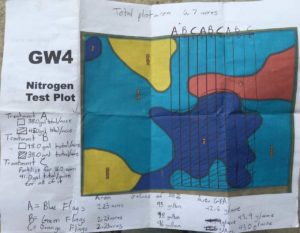Purdue encourages me to farm beyond the ‘status quo’
As one of my wisest advisers once told me, if you farm the same way your grandparents did, you will be farmed out of business. Looking forward toward this last year at Purdue University I would like to step back and look at how Purdue Agronomy has influenced me to think a little different and be willing to experiment and try new things on our farm.
Before I went to school, I will be honest, our Nitrogen strategy for corn was rather crude and simple. Expect the corn to live on just a little bit of nitrogen from the starter and then lay a flat rate of 150 lbs on at side dress. Our strategy did not take into account N credits from previous crops, field yield history, or even soil types or organic matter. Why did we do this? Number one, our old applicator was a rather cantankerous jerry-rigged contraption that was poorly designed and difficult to adjust. Number 2, that strategy has been what we did for the past 30 years and why change something that works.
Thanks to some inspiration from faculty and staff at school as well as the long overdue investment in more accurate and consistent application equipment, we are continuously making improvements to our nitrogen strategy as time allows. Last year we experimented with applying the recommended 1/3 of the N needs at pre-plant as well as taking into account the previous crops grown and the N credits associated with those crops. We liked what we saw and made adjustments to our strategy.
With the raven controller from our new applicator, we can also apply two separate rates on the fly with just a flip of a switch. With this ability I conversed with staff at school and agronomists at home for opinions on where to apply a higher rate and where to apply a lower rate. To my surprise, I got conflicting answers. Some recommended a higher rate on the more productive ground which has more OM and some recommended less on the more productive ground since the increased OM supply’s more mineralized Nitrogen depending on the year. As a result, I have started a 3-year experiment that takes into account variability within the field and from year to year so we can decide for ourselves what is the best decision for our farm. The plot pictured below I started this year.

I will likely continue this plot for years to come in different variations to keep up with differences in hybrids as well as weather. Starting next year I am interested in starting a second plot that plays with economic rates and I will use economic rates that I accumulate over time to make sound decisions for the future. Since economic rates will change from year to year depending on price of fertilizer, corn, and weather, this will be a challenge. The information gathered on our farm however will help make much better recommendations for our farm than the well known Economic Nitrogen Recommendation calculator found online. Purdue encourages me to have a different approach to farming than I had before and I recommend it to anyone who wants to be no ordinary farmer.
Best of luck to all perspective and new students
Troye S. Hook
Purdue AGRY 2020
